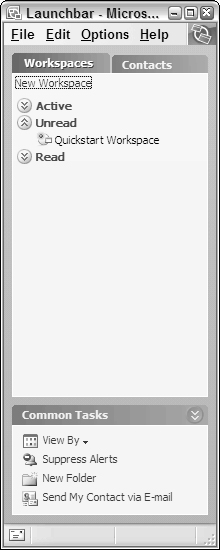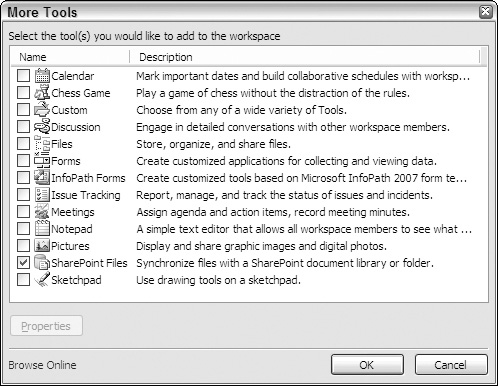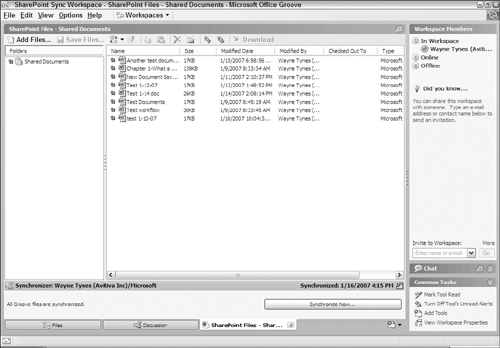Using Groove with Office Server
Groove is a collaboration tool that allows team spaces to be created on a client machine, which then replicates the Groove space to invited users. As data and content are added to any space, the data automatically replicates to other machines using technology that was compared to the Napster peer-to-peer sharing model when Groove was first released. Groove has several advantages:
Team members can exchange information within their Groove space inside or outside of a company firewall. Groove can be configured and managed without any assistance from IT because there is no need to configure firewalls, servers, security, or network access.
Groove features include presence information, chat, application sharing, file sharing, contacts, messaging, project management, data sharing, and content synchronization.
Groove can be fully customized by both technical and non-technical users with simple form development tools as well as Visual Studio.
Determining when to use Groove with SharePoint
SharePoint has document libraries, contact lists, data sharing, and presence information. Why would you use Groove and SharePoint together? One of the main reasons would be to share information with users outside of your organization. Although some companies have extranets that allow collaboration with external suppliers and vendors, many still do not. If a company has an extranet, there are still issues around account creation, security, and Internet access that make a combined Groove/SharePoint solution attractive.
Other useful advantages of Groove are the ability to collaborate both without the intervention of the IT department as well as Groove’s native ability to replicate collaborative spaces through firewalls. Many IT organizations block certain types of information and data packets from being sent and received. Groove has the ability to replicate through most firewalls unless an IT organization has taken steps specifically designed to block Groove.
Changes in Groove integration
In 2003, Groove Networks announced a product called The Groove Mobile Workspace for Windows SharePoint Services. It was positioned as a product that allowed users to create local, offline copies of their shared workspaces. Both list content and documents could be accessed and updated in the mobile workspace, which also synchronized with SharePoint.
After Microsoft acquired Groove Networks and created the new Groove 2007 version, they elected to support only document library synchronization and remove the support for synchronizing lists. This change was a bit of a surprise because we typically see additional features added in new releases. Your authors suspect that bundling Groove into the Office 2007 offering forced the team to make feature cuts to ship on time, and we will probably see interesting increases in the feature set for future releases.
Groove/SharePoint ScenarioHere is a business scenario: Jim works as an attorney for a large pharmaceutical company. The company is planning to acquire a rival company and is working with an external law firm that specializes in mergers and acquisitions. The team has three weeks to prepare for a meeting in Boston. Jim’s company is headquartered in Boston and the external firm contacts work in Washington, DC. The internal legal team created a great SharePoint site to manage all of the content and then called on IT to create accounts for the external firm contacts Jim is working with. The IT staff indicated they would need VP approval and then sent Jim to a Web site where he can make the request. After reviewing the business justification templates and the 15 steps to complete, including the creation of VPN accounts, network accounts, smart card activation, and so on, Jim worries that he will not be able to meet his deadline. During lunch the next day, Jim talks with Bob in accounting about his challenges, and Bob points Jim to the Office 2007 product Groove. Jim installs Groove from the internal server and in 30 minutes has a new Groove space. He points Groove at the key SharePoint document libraries that contain the merger project documents and then e-mails an invitation to the outside firm contact, Linda. Linda receives Jim’s e-mail, downloads a copy of the Groove client from the Web, and in 30 minutes has a full copy of all the documents on Jim’s SharePoint site. After reviewing several and making changes, Linda heads to lunch. Jim’s machine began synchronizing the document changes within minutes of Linda making them, and Jim’s laptop copied the changes to the SharePoint server where they are now available to everyone in the corporate legal department. |
Document library synchronization
Documents are synchronized between SharePoint and Groove via the Groove SharePoint Files Tool. Although this integration provides the benefit of offline SharePoint documents to the mobile worker as well as the ability to share them with colleagues across firewalls, there are a few limitations to be aware of:
The tool maps to documents stored in MOSS/WSS 2007 libraries only—SharePoint and WSS 2003 are not supported with the Groove 2007 install.
SharePoint metadata isn’t supported in the Groove space.
The tool doesn’t recognize custom SharePoint views, so users may notice more documents in the Groove folder because some documents may have been filtered out of the SharePoint view.
Note
We recommend having versioning enabled on SharePoint libraries that are synchronized with Groove to help reduce the risk of data loss that might occur because of synchronization errors or conflicts.
The following example walks you through how to set up a document library synchronization with Groove. Follow these steps:
1. | In SharePoint, go to a document library that has a few documents or import a few sample documents to use in this tutorial. |
2. | Launch Groove. |
3. | Create a new workspace by clicking New Workspace, as shown in Figure 13.26. Figure 13.26. Groove launch bar
|
4. | Give the new workspace a name like SharePoint Sync Workspace. |
5. | Select Standard and click OK. |
6. | Click Add Tools in the Common Tasks section in the lower right-hand corner of your Groove workspace. |
7. | Select the SharePoint Files tool as shown in Figure 13.27 and click OK. Figure 13.27. SharePoint Files tool
|
8. | Click the Setup button to select your document library. |
9. | Either select your document library from My Network Places or paste a URL, such as
http://portal/SiteDirectory/office/Shared%20Documents, into the Address field. Click Select and then Select again to confirm the library. You will see a synchronization dialog box briefly and then your documents will show up in the SharePoint Files tab as shown in Figure 13.28. |
10. | Click Add Files and select a test document to add to the Groove space. |
11. | Click the Synchronize Now button at the bottom of the screen. A Preview Synchronization dialog box allows you to preview the documents that are to be synchronized. Click the Synchronize Now button. |
12. | Go to the SharePoint site and refresh your browser. You should now see the document in your SharePoint document library. |
This example illustrates how easy it is to have a full library of documents that can be shared with a team anywhere in the world, while keeping a central document library on SharePoint up to date.
This hub-and-spoke approach is what distiguishes this solution from saving a document library to Outlook. Outlook gives one user the ability to take a library offline—Groove adds the ability for that user to then invite whomever he or she wants from any other organization to share and collaborate on those same files.
Check-in/check-out in Groove
When a file is checked out in the SharePoint Files tool in Groove, a lock is placed on the document in the SharePoint library. The lock prevents users on the server from editing your document while collaboration or editing takes place in one or many Groove spaces. A file does not need to be checked out for it to be updated in Groove; the feature just ensures exclusive editing rights.
To check out a file in Groove:
1. | Select the file or files to be checked out. |
2. | Select Edit
|
To check in a file in Groove:
1. | Select the file or files to be checked in. |
2. | Choose Edit
|
3. | You are prompted to comment on the changes to the file. For multiple files, the box lists the first file and then redisplays for each subsequent file after you click OK. Another option is to check in all files by clicking Edit
|
Discarding a checkout removes the lock on the file on the SharePoint library and overwrites the document with the most current version in the library. To discard a checkout:
1. | Select your file or files. |
2. | Select Edit
|
3. | Optionally, you may discard all checkouts by selecting Edit
|



